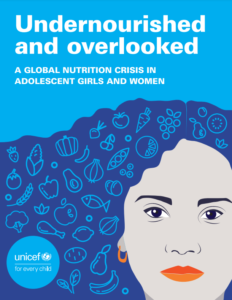
Highlights
Undernutrition, micronutrient deficiencies and anaemia amplify gender inequalities by lowering learning potential, wages and life opportunities for adolescent girls and women, weakening their immunity to infections, and increasing their risk of life-threatening complications during pregnancy and childbirth.
In ‘Undernourished and Overlooked: A Global Nutrition Crisis in Adolescent Girls and Women’ UNICEF examines the current status, trends and inequities in the nutritional status of adolescent girls and women of reproductive age (15-49 years), and the barriers they face in accessing nutritious diets, utilizing essential nutrition services and benefiting from positive nutrition and care practices.
The analysis focuses on undernutrition, micronutrient deficiencies and anaemia because these forms of malnutrition affect the most vulnerable adolescent girls and women in low- and middle-income countries, especially in the context of the ongoing global food and nutrition crisis.
Research highlights:
UNICEF’s findings reveal the slow global progress on nutrition in adolescent girls and women, and the multiple, interacting drivers that underlie this global crisis. The key findings are as follows:
- Progress on adolescent girls’ and women’s nutrition is too slow and under threat: no region is on track to meet the 2030 global targets to reduce anaemia and low birthweight, and acute malnutrition has risen by 25 per cent since 2020 in crisis-hit countries.
- Disadvantaged adolescent girls and women and those living in poorer regions bear the brunt of undernutrition and anaemia.
- Poor nutrition is passed down through generations: about half of children under 2 with stunting become stunted during pregnancy and the first six months of life.
- The global food crisis is deepening the nutrition crisis for adolescent girls and women.
- Adolescent girls and women struggle to access nutritious diets.
- Harmful social and gender norms and practices block progress on adolescent girls’ and women’s nutrition.
- Nutrition services and social protection programmes are failing to meet the nutrition needs of adolescent girls and women, especially in humanitarian settings.
- Adolescent girls and women lack strong policy protection against undernutrition.
Conclusions:
The scale and consequences of undernutrition, micronutrient deficiencies and anaemia in adolescent girls and women are being overlooked and under recognized by families, society, governments, development and humanitarian communities, research and academia, media and the private sector. Unless decisive action is taken, we will collectively continue to fail adolescent girls and women, and jeopardize the survival, growth, development and well-being of their children.
With the mounting pressures on food and nutrition security and rapidly approaching deadlines for the global nutrition targets, governments and their development and humanitarian partners – national and international – must take the lead in accelerating progress for adolescent girls’ and women’s nutrition.
>>> Access Undernourished and Overlooked data tables
>>> Access data on the triple threats of anemia, underweight and overweight